Biolaminin 332 LN (LN332)
Full-length human recombinant laminin-332
Biolaminin 332 is a full-length human laminin-332 protein that supports cells in epithelial basement membranes in several tissues.
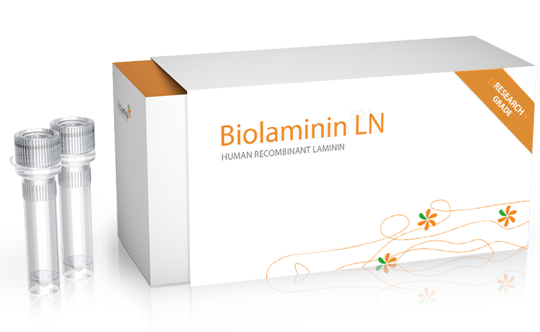
A biologically relevant culture environment
Laminin-332 highly influences keratinocyte proliferation and mediates a strong adhesion of keratinocytes to the basement membrane through hemidesmosome protein complex (Ghohestani, 2001). Laminin-332 is highly enriched in epithelial basement membranes.
The importance of laminin-332 mediated adhesion in the skin is also evident in the human blistering disease Junctional Epidermolysis Bullosa, which is associated with laminin-332 gene mutations (DiPersio, 1997).
The expression of laminin-332 is upregulated during wound healing and has important effects on keratinocyte migration, invasion and eventually tissue remodeling (D’Alessio, 2008).
Learn more about full-length laminins:
Laminin-332 is highly expressed in the catagen phase by keratinocytes in the basement membrane zone of hair follicles. It antagonizes laminin-511 driven hair growth in vitro of human hair follicles and, thus, hair growth has been suggested to be controlled by the relative expression of laminin-511 and laminin-332 (Conti, 2003; Sugawara, 2007; Li, 2003).
Structural changes in the RPE basement/Bruch’s membrane (BrM) lead to alterations in the RPE-matrix adhesion which is commonly the cause for retinal diseases (Zarbin, 2004).
Laminins are produced by and secreted from RPE cells themselves into the RPE basement membrane (Campochiaro, 1986). In particular, the RPE cells produce and bind the strongest to laminin-332 and in vitro, laminin-332 preserves phenotypic stability of mature RPE cells the best (Aisenbrey, 2006).
Recommended applications
-
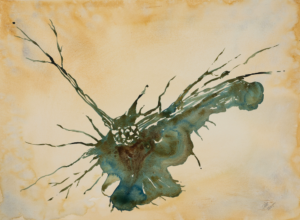
Cancer cells
Biorelevant culture of cancer stem cells on Biolaminin substrates Cancer cells use laminin/integrin signaling pathways that promote tumor cell growth, invasion, and […]View application -
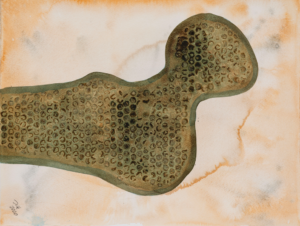
Bone and cartilage cells
Biorelevant culture of bone and cartilage cells on Biolaminin substrates High expression of laminin isoforms in the bone microenvironment Bone cells, including include […]View application -
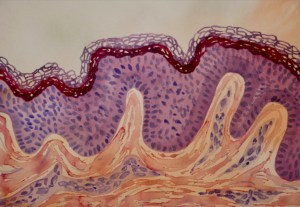
Skin cells
Biorelevant culture of keratinocytes on Biolaminin substrates The basement membrane composition in the epidermis Human epidermal keratinocyte (HEK) cells are […]View application -
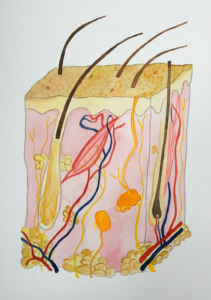
Hair follicle cells
Biorelevant culture of hair follicle stem cells on Biolaminin substrates Epithelial tissues contain a-5 and a-3 laminin isoforms Epithelial tissues are […]View application
Key features
Coating plates
1. Thaw recombinant laminins slowly at +4°C before use.
2. Dilute the thawed laminin stock solution with 1x DPBS.
3. Add the diluted laminin solution to tissue culture-treated surfaces, aiming for a final coating concentration of 0.5-2 µg/cm². The optimal coating concentration may vary depending on the specific cell line.
4. Seal the plate (e.g., with Parafilm®) to prevent evaporation, and incubate at +2°C to +8°C overnight. For faster coating, incubate at +37°C for 2 hours. Ensure the laminin solution is evenly distributed across the surface. Note that the laminin matrix will become inactivated if allowed to dry.
Important notes
Preparation and handling
- Perform all procedures under sterile conditions using aseptic techniques.
- Minimize exposure of the protein to ambient temperatures.
Storage and stability
Laminin stock solution storage
- Store the frozen laminin stock solution at -20°C to -80°C for long-term stability. Refer to the product-specific Certificate of Analysis (CoA) for detailed shelf-life information.
- Avoid repeated freeze-thaw cycles.
- For long-term storage of thawed stock solution, dispense into working aliquots and store at -30°C to -80°C. Thawed, undiluted Biolaminin stock remains stable for 3 months at +2°C to +8°C.
Coated plate storage
- Store coated plates aseptically at +2°C to +8°C for up to 4 weeks. Do not let the surface dry.
Cell culture setup
- Use appropriate culture media and dissociation reagents to create fully defined, animal component-free protocols.
- Ensure high-quality cells when transferring to the Biolaminin matrix.
- When moving your cells from another feeder-free matrix (e.g., Matrigel), we recommend starting with a smaller well format (e.g., 96-well or 48-well format) and a higher seeding density for the first few passages. This allows the cells to adapt to the laminin matrix before increasing the culture well format and lowering the seeding density.
Troubleshooting Guide
Biolaminin plate coating
Uneven cell spread is often a coating issue and may be caused by:
- Low coating concentration: Ensure the laminin coating concentration is high enough to support even cell growth. Increase the concentration if necessary.
Poor coating coverage or plate drying: Confirm that the entire surface is covered with the laminin coating solution when preparing fresh plates. Avoid drying out the plate, as this will inactivate the laminin. Prolonged time in the incubator or long storage without proper sealing can cause evaporation, leading to localized drying, often in the center of the plate.
Product name
Biolaminin 332 LN
Product code
LN332-0202
LN332-0502
Declaration
For research use only
Storage
-20°C to -80°C
Concentration
0.1 mg/ml
Appearance
Clear, colorless, buffered solution with a
pH of 7.2 with 10% glycerol and 0.02% NaN3
Shipping condition
Dry Ice
Protein name
Laminin 332 (Laminin-5)
Classification
Animal origin-free, human recombinant protein
Product application
Culture of keratinocytes, RPE cells, and hair follicle stem cells
Size guide
Not sure how much laminin you need? To make it easy, we have created a tool where you can calculate the amount needed for your experiments. Just choose culture well format and fill in the desired coating concentration to see the amount required.
Please see the coating instructions for concentration and volume guidelines.